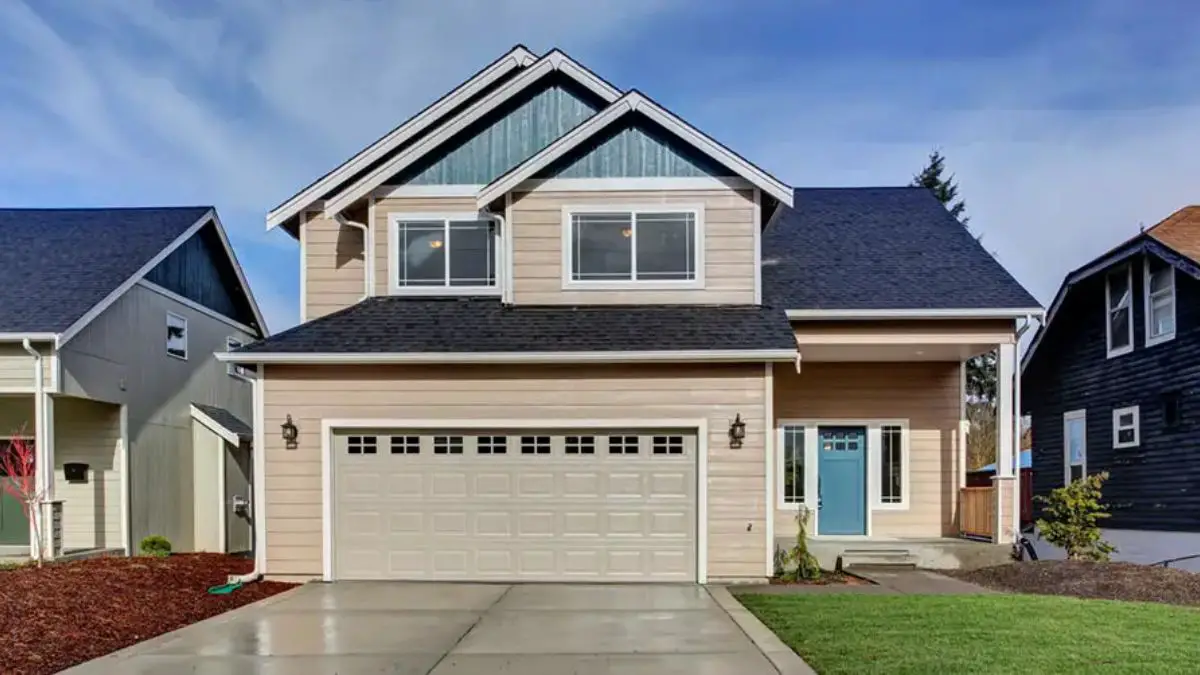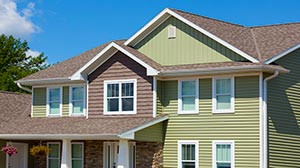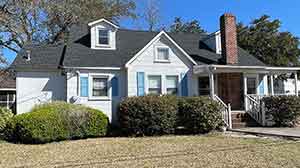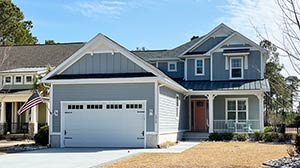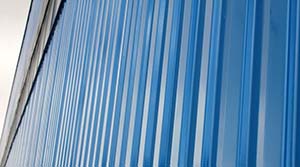Installing siding on your home can be costly, especially when you consider factors like Home Siding Costs. There are many types of siding available, and selecting the right one can get stressful. With careful planning, your project can improve your home’s appearance and value.
One of the most significant issues with rehab comes down to costs. Almost every investor wants to cut costs and get the most value. So, how much does the siding cost?
For example, new vinyl siding will cost between $6,150 to $15,900 for 1500 to 2500 square footage.
House siding cost depends on the size of your home and the type of siding you choose. When choosing house siding, people consider their preferences and budgets.
We will talk about how much it costs to install popular types of sidings for your home’s look. During our conversation, we also discussed the prices of materials and labor for various home sidings. We also discussed the advantages and disadvantages of using specific sidings.

How Much is Siding for an Entire House?
Your average home is anywhere between 1,500 and 2,500 feet. Since this is true, most of our average costs will come from that specific bracket.
To guide your decision, the cost per square foot values can help you upscale or downscale.
We have compiled a chart below for a home ranging from 1,500 to 2,500 square feet.
| Material Used | Cost Per Square Foot | Installation Costs |
|---|---|---|
| Vinyl | $1.30 to $10 | $3,500 to $26,000 |
| Stucco | $5 to $6 | $1,830 to $7,052 |
| Wood | $8 to $12 | $16,000 to $24,000 |
| Engineered Wood | $4 to $12 | $6,000 to $30,000 |
| Aluminum | $2 to $5 | $10,000 to $19,000 |
| Steel | $4 – $8 | $4,000 – $14,600 |
| Fiber Cement | $5 to $13.50 | $6,000 to $20,000 |
| Brick | $9 to $28 | $8,900 to $25,000 |
| Stone | $35 – $50 | $87,500 – $125,000 |
Siding costs are National Averages, which vary based on where you live. From the guide above, you can see that wood and aluminum are cheap siding options. But natural solid stone is much more expensive.
The price difference is due to the challenge of obtaining and shaping the material for your home.
A professional siding project costs about 40% materials and 60% labor. These will vary with the type of siding and the complexity of the installation.
If you replace the old siding, you must pay extra to remove the current siding materials. Also, you may need to fix hidden water damage.
Wood, Vinyl & Aluminum Siding
Wood, vinyl, and aluminum are easily cut into shape and apply to your home.
They are easy to work with, so they are cheaper. But the stone is different. Remember, some wood siding needs more money for staining, sealing, or painting. Whereas vinyl and aluminum siding often come in various colors and are ready to install.
Stone Siding
The stone is heavy and needs skilled installation to look good.
Before installing the stone, test your home to ensure it can handle the weight. We do this to protect the structure of your home.
Most Common Types of Exterior Siding and Their Costs
Aesthetic matters, especially with materials like stone. But it’s also important to consider a tactical approach for your siding. Make sure it enhances the look of your home and impresses both you and your neighbor.
But, it stands the test of time. It doesn’t become a constant battle of upkeep and regular maintenance.
Below we will go over some of the most popular kinds of siding. We will also talk about the best environments for your siding. This will protect it from insects, water, and moisture damage. We will find a solution that is affordable and not too much work.
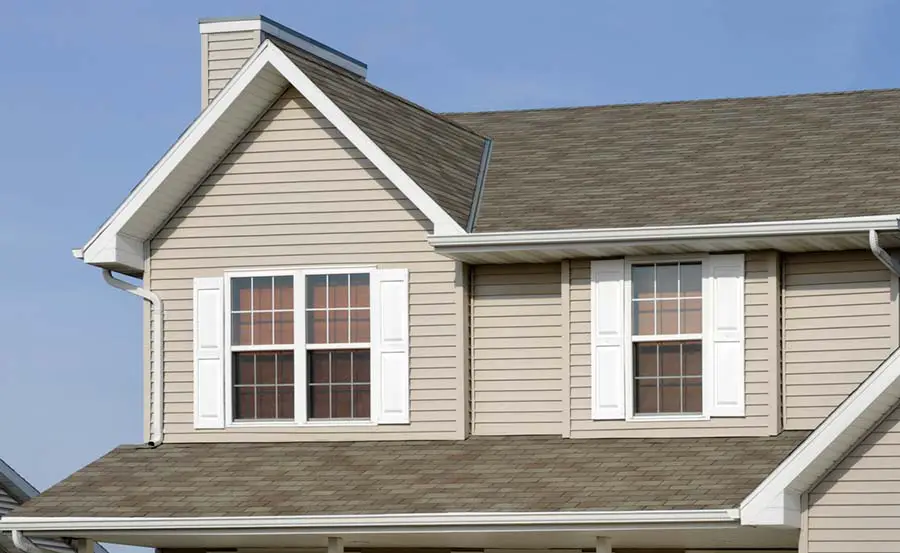
Vinyl Siding Types and Costs
Vinyl siding is inexpensive, durable in all weather, and offers more customization than other choices.
You can expect vinyl siding materials to cost $1.30 to $10 per square foot. Professional installation can cost $4,500 to $26,000 for a 2000 square foot house. The US national average is $9,000 for most home siding projects.
There are two main differences in vinyl sidings: cost and quality. Vinyl sidings can be cheap or expensive, depending on their quality and insulation. The qualities that vary are texture and durability.
| Types of Vinyl Siding | Average Costs per Square Foot (Material Only) |
|---|---|
| Hollow | $1.30 – $4 |
| Premium | $2.50 – $8 |
| Insulated | $8 – $10 |
Vinyl siding is cheaper, so it’s known worldwide as the most popular choice for siding. Other exterior siding options are more upscale and last longer.
Traditional Vinyl siding has two great qualities: it’s easy to install and it’s affordable. This means you’ll save money on labor costs.
Vinyl siding can look like other types of siding with different textures and styles. But, there may be a noticeable difference when viewed from far away. High-quality vinyl is thicker and resists color fading more than standard vinyl materials. The table below displays the cost of vinyl siding styles and their estimated material costs.
| Vinyl Siding Style | Average Cost per Square Foot (Material Only) |
|---|---|
| Traditional Lap | $1.30 – $6 |
| Smooth | $1.30 – $6 |
| Beaded | $1.30 – $6 |
| Dutch Lap | $1.30 – $6 |
| Clapboard | $1.30 – $6 |
| Board and Batten | $2.50 – $8 |
| Vinyl Shake | $2.50 – $8 |
| Scalloped | $3 – $8 |
| Log-Look | $4 – $10 |
| Brick-Look | $4 – $10 |
| Stone-Look | $4 – $10 |
People imitated natural wood to get value from the mimicry.
Omit its installation, it’s almost a fire and forget job with the vinyl. You can use it on almost anything, such as the options mentioned in this article. Another feather in vinyl’s cap comes from its broad color customization.
Vinyl provides different options if you don’t want a wood-like look, but it won’t raise your home’s value. A poor vinyl siding installation could affect the value.
Vinyl siding needs less prep work and maintenance than other sidings on this list. Cleaning, especially if there is dirt or grime from lawn care, makes it look nice.
Uninsulated vs. Insulated Vinyl Siding Explained
When picking vinyl siding, consider its thickness and insulation. The term “hollow back” is generally used to describe uninsulated vinyl siding.
Uninsulated siding has an R-value of less than 1.0, so by itself provides no insulating value.
Vinyl that is thicker with a foam backing describes insulated vinyl siding. Insulated vinyl siding is 3 to 10 times better at trapping heat than uninsulated siding. But, it also increases the cost .
Insulated siding has an R-value between 2.0 and 5.0. In colder climates, adding insulation to the outside of your home is important.
House with wood shingle siding

Wood Siding Types and Costs
Many homeowners choose natural wood siding for its timeless beauty and qualities. If cared for, wood siding can last forever, but the typical lifespan is 30 to 80 years.
Wood siding materials range in cost from $1 to $20 per square foot, depending on the type.
On average, natural wood siding costs $8 to $12 per square foot. The cost of installing it completely by professionals ranges from $16,000 to $24,000. This is for a normal one-story home that is 2000 square feet. Wood siding costs vary by species and type. Horizontal lap siding installation costs less than the more labor-intensive wood shingle siding.
| Type of Wood | Average Costs per Square Foot (Material Only) |
|---|---|
| Plywood/T-111 | $1 – $2 |
| Pine | $1 – $5 |
| Fir | $2 – $6 |
| Douglas Fir | $3 – $5 |
| Cedar | $3 – $30 |
| Engineered | $4 – $12 |
| Redwood | $4 – $20 |
| Accoya | $5 – $10 |
| Teak | $5 – $12 |
| Cypress | $5 – $12 |
| Spruce | $6 – $11 |
| Ipe | $8 – $18 |
| Garapa | $9 – $20 |
The most common trees cut into wood siding are pine, oak, spruce, cypress, cedar, redwood.
Natural wood has some fantastic perks up its sleeve. If you choose redwood, wood siding can last a long time due to its durability and resistance to pests.
To maintain the benefits of wood siding, you must be diligent in its maintenance. You can expect quite a battle if you live somewhere where it rains.
Wood rot, mildew, and termites are something that should come as no surprise when you go with wood siding. If you try to save money or forget, it can be expensive to separate those things later.
Wood siding is available for repairs – like vinyl siding.
To prevent these situations, paint or stain your wood siding every three to four years. Also, use mildew and fungicide deterrents to cut threats. If you need to remove siding, expect the costs to rise to 20% of the total siding project cost.
Grades of Wood and Cost
Based on the surface appearance, we grade wood products such as lumber and siding.
You can see knots and flaws on low-grade boards, but mid-grade boards have fewer flaws. Premium grades are almost flawless. Costs increase the better the lumber grade.
- Low-grade lumber is $1 to $3 per square foot
- Mid-grade lumber is $2 to $12 per square foot (most common)
- Premium-grade lumber is $3 to $30 per square foot
The most popular wood siding styles are:
- They make wood shingles and shakes from saw-cut and hand-cut wood pieces. They must a lot of labor to install.
- Bevel horizontal siding is clapboard siding that has a beveled edge. This allows the boards to overlap.
- Board and batten: vertical wood panels with wood strips covering the seams.
- Split-log: cut from logs with rounded edges to look like true log construction.
Let’s examine each.
Wood Shingles and Shakes
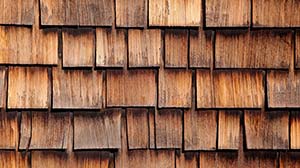
There are two distinct types of wood planks, each with its characteristics. But, their similar rectangular appearance confuses them. The distinction between the two is in the thickness and how their cut.
Wood shakes are ax-cut, while shingles are saw cut. Today, people cut shingles faster. Ax-cut shakes are generally thicker than saw-cut shingles.
Most shakes and shingles are either white or red cedar wood. You can also find redwood or pine shingles and shakes, but pine has a much shorter lifespan because it is softer. Cedar shakes are more insect resistant than pine.
Shakes are rare and come in different sizes, giving them a natural staggered look.
, shingles are the same size, but you can stagger them by using different sizes. You can also round off wood shingles to create a scalloped appearance.
Bevel Horizontal Siding

The wood siding known as “clapboard” angles . This allows thicker bottom edges to overlap thinner top edges. Nail siding across the thinner edge, and lay the next row over the edge to hide the nail heads.
Clapboard is often cedar, oak, pine, and spruce, but most wood species can be lap siding. These form long, horizontal planks of wood on exterior house walls. Boards are generally 1 inch thick at the bottom and beveled to about 1/4 inch thick at the top. Boards can be 10 feet or longer.
Recommended Overlap on Wood Siding:
| Nominal Size (in.) | Overlap (in.) |
|---|---|
| 4 | 1 |
| 6 | 1 |
| 8 | 1 to 1-1/8 |
| 10 | 1 to 1-1/2 |
| 12 | 1 to 2 |
Board and Batten
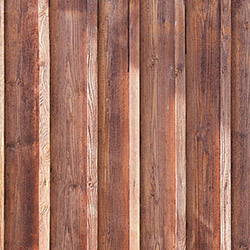
You can use the vertical wood panels instead of barn-style siding. They align side by side. A batten strip covers them to hide seams and keep water out.
The vertical batten strips create a 3-dimensional look that is appealing.
You can achieve a rustic look with plywood, pine, or fir wood. But, all types of wood are acceptable. You can leave board and batten siding natural or paint it.
Board and batten siding are the easiest wood sidings to install and maintain. To achieve a rustic look, some builders intentionally use lower wood grades with knots.
Split Log Siding
Many people dream of having a log home. Split log siding combines the attractive look of log cabins with the energy efficiency of modern homes. It costs much less than genuine log-built homes.
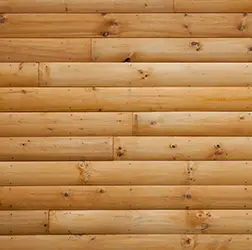
Split log costs $8 and $20 a square foot. Split logs are between 6 and 12 inches wide, 3 inches thick, and about 8 to 16 feet long.
There are many types of log siding, with the split log as the most prevalent. Split log siding is a log cut in half. The flat side faces inward, giving the home an authentic log cabin exterior.
Quarter log siding allows for cutting four pieces from a single log, which lowers the cost. The flat side faces inward like a split-log, leaving the rounded side visible.
To make cabins as air-tight as possible, we add chinking to genuine log homes to fill gaps between logs. But, chinking is generally not needed for log siding but can add a more realistic look.
Wood Siding Requires Upkeep
Wood siding requires one of the highest levels of maintenance. To protect wood from damage, it’s important to maintain it and prevent moisture and pests. You’ll need to apply a water sealant every 2 to 3 years. You’ll need to every 4 to 7 years if painting or staining.
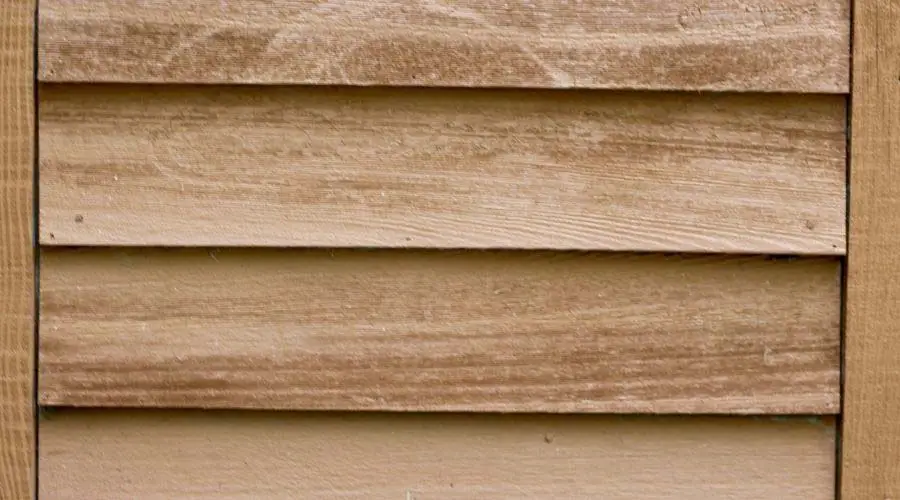
Engineered Wood
Engineered wood siding costs $4 to $12 per square foot on average and can last 50 years. The cost to install a 2,000 square foot area is around $20,000. On average, that’s about $10 per square foot.
All composite and engineered wood sidings can vary , so compare manufacturers . Engineered wood siding is often prefinished or painted, which makes it less expensive to install than other wood products.
Of course, it makes sense to switch from real wood siding to a factory-made finish. Engineered wood siding has the same benefits as traditional wood, but it’s cheaper.To an extent, it has more durability than its natural counterpart.
Engineered wood doesn’t have the same problems as natural wood siding.
You don’t have to worry about bugs, mildew, wood rot, or fungus with this artificial beauty.
Homeowners can save money on labor and prefer using natural wood for lower costs.
You can use it in different weather conditions because it doesn’t warp.
You can choose expensive wood bases for your preferred look without paying the full cost.
When you choose engineered wood, you have more options for its appearance and save money on your renovation.
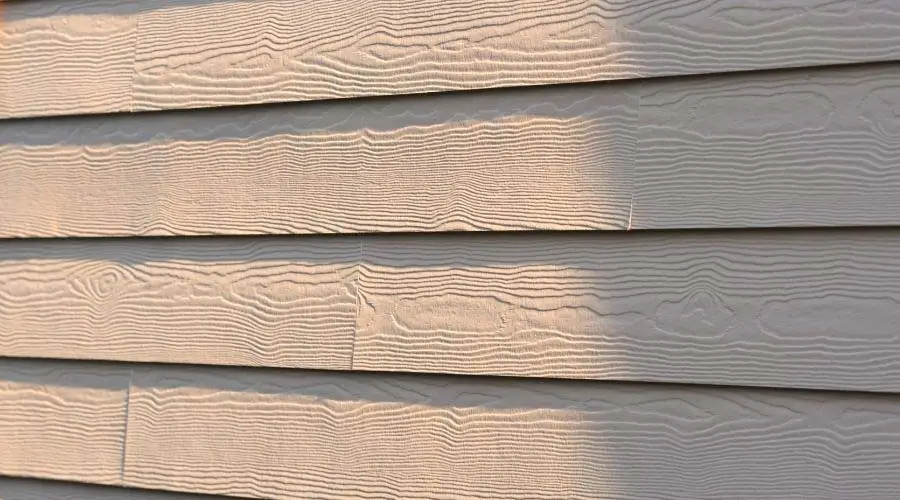
Fiber Cement Siding Products & Costs
Fiber cement is next on the list. It has benefits like only a few other types of siding. Fiber cement is also known as cement board, Hardie board, or Hardie plank, like the products from James Hardie company.
But, few of them have the same weather resistance as fiber cement. Plus, it’s not as affordable as you might think.
Wood pulp, cement, clay, and sand make all fiber cement products.
Fiber cement is about as long-lasting as vinyl, but it lacks the look of plastic. The material will last for 50 to 100 years. Sometimes, the surface needs repainting every 8 to 10 years for looks.
Fiber Cement Board Cost Breakdown
At its absolute lowest, you can expect to pay $4.00 for a square foot of fiber cement siding. Some styles are about $10 per square foot.
Fiber cement siding is strong against heat, bugs, cracks, peels, flakes, and moisture. It won’t ruin like wood.
The usual cost to install fiber cement lap siding is $9.00 to $16.00 per square foot. You also need to consider the cost of painting.
The likely cost is about $13 per square foot for fiber cement shakes.
The average-sized American home needs about 2,000 square feet of siding, or about $18,000 to $32,000. The cost of the siding job depends on the details, choices for trimming, and your home’s design.
Installing fiber cement is hard work. It takes at least two people to carry and hold each board.
According to the 2019 NARI Remodeling Income Report, fiber cement siding and vinyl siding both have a 9.3 Joy Factor. Homeowners who chose fiber cement siding recouped 76% of their investment. Those who chose vinyl siding recouped 63%.
Fiber Cement Siding Options
Another perk that comes with fiber cement would be its high level of cosmetic expression. It comes in a wide array of colors that can mesh with almost any home.
To top it all off, you don’t have to do much more than pressure washing it to keep it looking nice.
Fiber cement, like steel siding, offers various styles that can help you easily.
You can make your home look exactly how you want it with different siding styles. These styles can also mimic other types of siding we have listed.
Fiber cement is not something you can tackle without some experience. You should hire a professional to install fiber cement because it’s a complex task.
- Hardie Plank Fiber Cement Boards
Fiber cement siding, like vinyl, is usually designed to look like bevel wood siding. Local siding contractors often refer to cement board or Hardie Plank. But, manufacturers other than James Hardie make fiber cement board products.
Brands other than the Hardie Plank brand are often less expensive, which can factor into the cost. Ensure your siding professional contractor is installing a quality brand of fiber cement siding.
Both smooth, textured, and shaker-style Hardie Plank siding are available.
- Shake and Shingles
James Hardie and other manufacturers have 48-inch boards for shingle siding. The boards can be straight or staggered edge.
James Hardie offers HardieShingle siding in various colors. You can choose between straight or staggered edge styles. If you don’t see a color you like, a pre-primed paint-ready siding is available.
Allura.com is the top-rated website for fiber cement siding. They offer a variety of options, such as different colors and styles, like octagon shakes, half-round shakes, and 5 to 7-inch shakes.
- Vertical Panels
Vertical fiber cement panels mimic wood or stucco. They’re 4 ft wide by 8, 9, and 10 feet tall, or long is the standard size of this design. There are two finishes: smooth and wood grain.
- Artisan Lap
James Hardie produces a high-quality horizontal plank lap siding. It’s also called architectural grade. They come in a few models with enhanced structural integrity and cutting-edge technology.
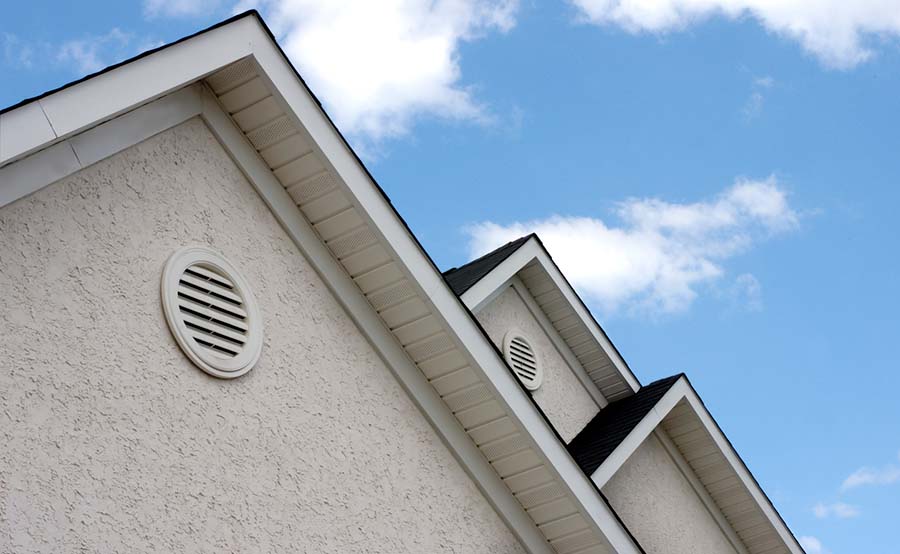
Stucco Types and Costs
Stucco is well-known in the siding world, though not as popular as vinyl. It’s on our list because of its popularity.
Stucco is a type of siding made from cement and sand. It is fire-resistant, bug-resistant, and affordable. If you live in a dry climate, stucco is a good option. But, if you have constant rain or damp conditions, stucco may peel and crack in wet weather.
There are different stucco options, but in reality, only one is practical. Because it is a textured material, there are many possibilities.
Stucco consists of plaster made from sand, cement, and lime. The makers of exterior stucco have created durable materials that withstand the elements. Cement stucco differs from gypsum plaster in that it uses cement as well.
Stucco offers a wide range of colors and textures for you to choose from. You can create many different color combinations with stucco.
Cost of Stucco Siding
On average, you’ll pay between $3 and $14 per square foot of stucco, including labor charges. Material prices run $1 to $5, while labor costs add $2 and $9 a square foot. The type of stucco and the property location determine this. Stucco is more popular in some areas and less so in others, affecting the installation cost.
| Type of System | Average Cost per Sq.Ft. (Materials Only) |
|---|---|
| One-Coat | $1 – $3 |
| Three-Coat | $2 – $4 |
| EIFS | $3 – $5 |
A typical 2000 square foot home can cost $6,000 to $28,000, but the national average installation cost of $12,00 to $16,000.
One-Coat Stucco Application
Using only one coat during the process makes it the less costly option. The one coat comprises cement fibers, water, and chemicals.
One application combines the scratch and brown coats of the three-coat method. The one-coat system is better than the three-coat technique. Applying it is quicker and it offers the same fire resistance, durability, flexibility, and protection.
The major disadvantage is that it is thinner and more prone to damage than the three-coat system.
Three-Coat Stucco Application
Three major layers make up the materials used in the process.
- We apply a mixture of cement, lime, sand, and water over paper and wire mesh as a base.
- a scratch coat base layer
- a brown coat layer
After applying three coats, you will add a finish layer called the “topcoat.” This layer is not counted as one of the stucco layers, but it is necessary. The base layer is the most weather-resistant base layer.
People value three-coat systems for their durability. They are thicker and can withstand wear and tear better than one-coat methods. The drawback is that it takes more time and money to install than a one-coat application.
EIFS Siding Stucco Application
EIFS is a type of stucco that has many thin layers over foam insulation. It also has a topcoat to protect against moisture. To make it, glue the foam board to the wood. Then, add mesh or lath and let it dry. They apply the final finish coat from there.
Flexible polymers make up the topcoat. They are less likely to break and more resistant to water. It’s like the other three in color and texture possibilities.
EIFS has been prone to moisture damage and can be very costly to repair. To find and fix problems early, it’s recommended to inspect stucco.
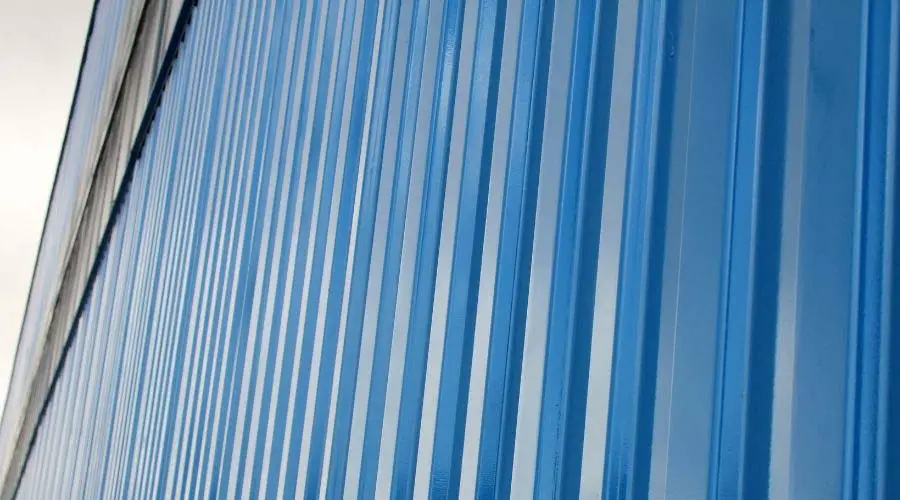
Metal Siding Types & Costs
There are several types of metal siding options. Aluminum and tin are often used for entire houses, while copper is better for accents. People often use steel and insulated steel in commercial buildings, but they can also use them in larger homes. We will explore each below; but, we will spend more time on some than others.
| Material | Average Costs per Square Foot (Material Only) |
|---|---|
| Tin | $1 – $3 |
| Aluminum | $2 – $3 |
| Steel | $4 – $6 |
| Insulated Steel | $5 – $6 |
| Vinyl-Wrapped Aluminum | $5 – $7 |
| Corrugated Steel | $5 – $8 |
| Zinc | $15 – $20 |
| Copper | $20 – $30 |
Tin Siding
Tin siding is a type of metal siding that is not common today. People use it on barns and storage buildings, as well as hunting sheds. It also has some commercial uses. Tin siding comes in panels or sheets and is lightweight with a corrugated appearance. It is easy to cut and shape, but it also dents . This metal is not very strong, so it is usually used for less important structures.
Aluminum Siding
Being cost-effective is one of aluminum’s primary namesake. You can cover a lot of ground with sheets that cost $2 to $3 per square foot.
Aluminum is a metal that resists fire, rust, mildew, and water damage. But, what might surprise you is how beautiful it can look with a fresh coat of paint.
When painting aluminum, it’s important to use specific types of paint for siding and metal. You will want to aim for high-quality exterior 100% acrylic latex paint in almost every case.
Some types of this paint are better for covering up any marks or scratches that might show up later. Choose a matte finish instead of a reflective or glossy one. Aluminum can get dented from a simple touch, making it look unattractive.
If severe weather or hail is frequent in your area, avoid using aluminum as it can get damaged. Otherwise, you will look to replace pieces often if you want to look pristine.
Aluminum siding costs run from $2 to $5 per square foot. Most aluminum siding projects cost $10,000 to $19,000.
Vinyl-Wrapped Aluminum Siding
PVC-coated aluminum siding is a less costly option than regular aluminum siding. It has an aluminum core and vinyl covering.
The coating on the siding is thicker and less likely to crack than regular vinyl. It also needs less maintenance compared to metal. It resists some minor dents and dings while being less prone to warp in the heat of the day than common vinyl.
While aluminum siding is fire retardant, vinyl is not.

Steel Siding
Imagine all the benefits of aluminum siding, plus extra protection from impact.
Steel is the most common metal for siding. Steel is much stronger than aluminum, so it doesn’t get dented . That durability makes it harder to work with than aluminum.
You can also get steel sides with a special finish that won’t fade, crack, or peel. It comes with a lifetime guarantee. Steel siding comes in a variety of styles and finishes.
But, if someone scratches away the steel siding finish, it can rust.
Steel is a stronger metal than aluminum, so it lasts much longer. Although it might cost more at first, the minimal upkeep and customizable finish make it worth it.
Many businesses have cheap steel siding choices, various colors, and modern-looking textures. You can have the beauty of natural wood without any rot, mildew, or insect damage problems.
One such company, “EDCO,” has a myriad of choices at hand for almost any style you could imagine.
You have several choices for the finish, including lap, vertical, and shake. These options will complement any color you choose. It saves you time and money on painting the finished product yourself.
Insulated Steel Siding Cost
Steel log-look siding is one of the newest styles available. Steel log-look siding is one of the most accessible types.
This siding is like a log and keeps insects away. To keep the interior warm, we fill the curved steel siding panels with insulation.
Corrugated Steel Siding Cost
People use corrugated steel siding on outbuildings and commercial structures. The siding comes in thick sheets, making it heavier and more durable than other materials.
The siding’s shape conceals wear and tear, so it is ideal for busy commercial buildings. Corrugated steel siding isn’t as popular as other types. There may be few alternatives.
Copper Siding
Copper is an excellent choice for home siding due to its resistance to rust and corrosion. In most cases, copper lasts more than 100 years.
Over time, copper develops a patina. It starts as dark brown and becomes blue-green. If you want to preserve the polished finish and color of copper, you’ll need a lot of attention and care.
Copper siding is expensive, costing $20 to $30 per square foot. It is best for roofs or accents.
Copper siding is a beautiful, if not daring, option. It is resistant to acid. To claim that it does not rust is incorrect because copper oxidizes. But, the way it alters over time adds to its appeal as a siding.
Copper is a very sturdy material. The metal’s natural color change lasts as long as the metal itself, even for hundreds of years. Copper is gaining popularity in modern buildings, suggesting it could be used for homes in the future.
Zinc Siding
Zinc siding is relatively uncommon. Zinc is available in panels and some types of lap siding. Zinc is costly, so it’s usually used to accent another siding. Zinc works well with brick, stone, and wood; it adds depth and intrigue to the property—a square foot costs between $15 and $20.
Zinc is a metal that does not corrode or rust, and like copper, it takes on a beautiful dark blue hue patina with age. The patina on the material protects it for its entire lifespan, so it never needs painting.
Zinc resists mold and fungus better than other metals, so water doesn’t run down it easily.
Zinc is less expensive than copper by about half, yet it’s still more expensive than aluminum. The cost to install varies based on the panel style and brand, usually between $15 and $20 per square foot.
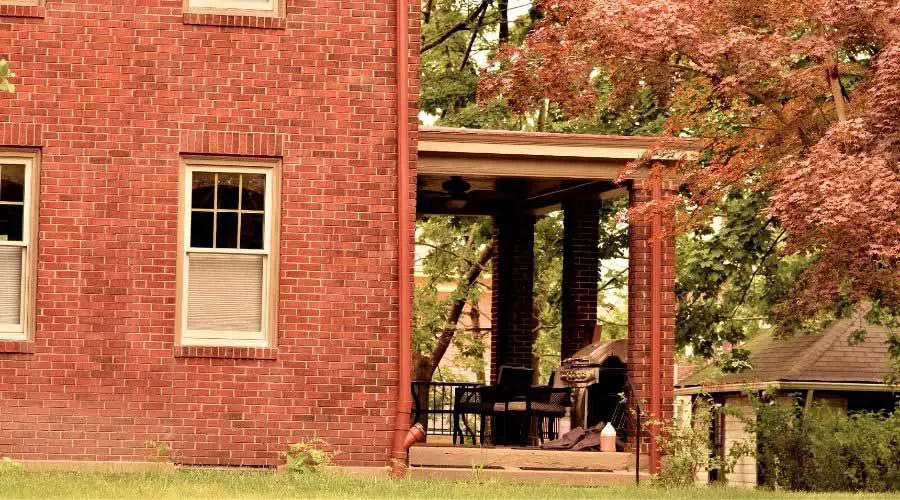
Brick Veneer Siding
Our list of sidings starts and ends with strong, simple brick veneer siding.
Even though it increases the cost, the return on your investment for sidings is impressive. You can expect it to be no pushover, assuming it’s installed.
Brick siding is one of the most large types of siding on this list. This material can withstand fire, lasts in any weather, and needs little upkeep for 20 years. The higher amount you pay upfront will save you in the long run.
If you want more expression on your home, you can paint the bricks to match your taste. But, you’ll have to keep up on the paint, which adds another chore.
Brick, like stucco, is often considered a type of stone. But, brick has unique qualities that set it apart. The composition of clay, cement, and gravel in brick makes it long-lasting and durable.
After a house is constructed, there are three types of brick buildings that offer various siding choices. During the building process, a home made out of brick supports the structure.
It’s on the exterior of a home, either thin or full brick, but only one layer thick. Homes built with brick use 2 layers of wythes.
Cost of Brick Siding Installed
The cost of brick veneer siding ranges from $12.50 to $20.00 per square foot installed. This varies depending on the quality of materials (thick vs. thin), who’s doing the job, and where it’s being done. The price range is generally between $14.50 and $18.50 per sq ft.
| Type | Average Costs per Square Foot (Material Only) |
|---|---|
| Traditional Brick Siding | $2 – $6 |
| Face Brick Veneer | $3 – $4 |
| Interlocking Brick | $5 – $25 |
| Panel | $6 – $10 |
| Handcrafted Brick Siding | $15 – $25 |
In most cases, brick veneer installation labor costs $3 and $5 per square foot. Brick walls with fancy designs can be expensive, ranging from $10 to $20 per square foot.
For the average brick veneer installation on a 2000 square foot surface area, expect to pay $14,000 to $32,000.
Traditional Brick Siding
Brick siding is made of full-sized bricks stacked with mortar and metal hangers on the frame.
The building looks like it’s made of bricks, but the bricks don’t support the structure. The best advantage of a brick veneer is the complete brick veneer, the masonry approach to building with bricks.
Bricks are porous, and water seeps behind bricks. The metal hangers help hold an air gap between the brick and wood substrate. Water flows out of the brick’s bottom through weep holes due to a weather-resistant barrier.
Face Brick Veneer
Today, most brick homes are clad in brick veneer. Because it is thinner than a standard brick, it is lighter and easier to install. It doesn’t must metal anchors and is simpler to support for most houses.
You can choose from different colors and finishes for the face brick veneer. You can mix and match them to match the look of your home.
They install like stone veneer. Start by securing metal lath to the sheathing/vapor barrier. Then, use surface grout to hold the brick in position.
A few choices use paneling systems instead of masonry. Metal panels with holders help to add bricks to the wall without scratching the grout. To achieve a distinct brick appearance, apply a surface layer of grout over the metal panel.
We do not recommend this because it reduces the insulation value of brick siding.’ It’s also not as long-lasting as a whole brick. This brick alternative looks like real brick, but it doesn’t last as long.
Interlocking Brick Siding
Interlocking brick tiles overlap instead of using mortar, so mortar is not needed. Installing brick siding in all directions is the simplest form to put up.
Rather than individual bricks, these go up many at a time. These pieces have seams and need mortar to be waterproof when installed. These materials come in various colors and sizes, which makes them a good match for other type of siding material.
Brick Siding Panels
Brick siding panels appear to be real bricks, but they are lighter. During the installation of panel brick siding, construction adhesive forms the bonds. These siding may not last as long as traditional brick or brick veneer because they are not as durable. They may only last 20 to 30 years.
Handcrafted Brick Siding
Today, factories or machines mix, extrude, and cut the clay to manufacture most bricks. People are still making hand-pressed clay bricks. These bricks have a greater degree of texture and variation than run-of-the-mill bricks. This may be helpful for rustic homes. This type of brick is often used as an accent with log siding houses because it is pricier than regular bricks.

Natural Stone Veneer
This list must include the priciest, stylish, and well-balanced siding of all. Natural stone siding is not affordable by any means. Natural stone veneer is an expensive siding option. It’s usually used as an accent focal point.
The cheapest kinds cost $30 per square foot, while the most expensive ones are under $50. It’s a big investment for your home. Before you install this strong siding, make sure to have your home and wallet inspected, just like any investment.
If your home can’t handle the extra weight of stone siding, you can’t use it. But if it can, you’ll get a beautiful, timeless siding that increases your property value.
Stone lasts over 100 years because it’s not affected by weather, impact, rot, or mildew. It’s a good investment.
Stone is the best siding, but it may not be worth using on certain homes. If you want the benefits of natural stone without the high price, consider stone veneer.
Veneer siding isn’t as heavy as actual stone siding and offers almost the same in every other area.
Stone Siding Installation Costs
Installation costs of stone veneer siding from $12 to $22 per square foot. Faux stone panels are between $4.50 and $10.00 installed square foot.
| Type of Siding | Costs per Square Foot (Installed) |
|---|---|
| Faux Stone Panels | $4.50 – $10 |
| Stone Cladding | $15 – $25 |
| Cultured Stone Veneer | $12 – $22 |
| Stone Veneer | $12 – $22 |
| Solid Stone | $19 – $45 |
Installing 2000 square feet of surface in stone can cost $20,000 to $60,000. While this is a wide cost range, for the average home, the cost is $37,500.
It’s easy to see why stone is more workable as an accent siding. Natural stone works well with fiber cement or real wood siding.
At first, stone siding seems costly, but it saves money in the long run.
Is House Siding Expensive?
If one says beauty is in the eye of the beholder, they must also say the same about general expense. Appreciate the capacity to endure challenges that your home might face.
You might be willing to pay more than $30 per sq. To avoid frequent repairs, maintenance, and painting, use stone instead of other materials.
The type of siding you choose and where you live affect its durability and potential problems.
Going with vinyl is excellent from a cost perspective. Still, suppose you are in an environment that has constant sun exposure.
If that happens, your vinyl will peel and crack, needing frequent siding replacements. As a result, the initial investment will accumulate over time.
To avoid spending a lot, choose siding suitable for your climate.
If you want both style and durability, you’ll have to pay more than choosing resilience.

How Much Does Siding Cost to Install?
To estimate the cost of siding installation, check the table at the beginning of this article. It shows the expected costs for materials and installation.
Every job is different. The more prep work needed, the higher the omit cost. If you have a stucco siding, you can save time and money by installing vinyl over it.
Still, you wouldn’t be able to tell if mildew or other things were happening under the surface.
Should I Install Siding Myself or Hire a Professional?
Choosing a professional for siding installation process depends on the type of siding and warranty preference. When deciding on siding, think about if you’ve installed it before or not.
If you’re skilled at siding, you wouldn’t need to hire a professional for warranty purposes.
But if you don’t have experience, installing it yourself could lead to more expensive problems. Your work might not be good enough, and then you could end up with water damage.
As we said earlier, you must have the correct tools and know-how to put up fiber cement siding.
Is New House Siding a Good Investment?
Your situation and previous siding determine the type of siding you should choose. Unfortunately, this decision is not easy.
Living in a hot place? Switching from vinyl to stone siding cuts maintenance and repairs. It also increases your property’s value by protecting against weather.
Additional Costs for Siding Jobs
You’ll need to pay extra for trim pieces, fascia, soffits, and corners. The length determines these additional costs. The trim can vary from $2 to $8 per linear foot.
Depending on the material, fascia and soffits are $25 to $45 per linear foot. Fascia and soffits can be vinyl and aluminum, fiber cement board, or real wood.
Home Siding Costs FAQs
Below are answers to your most frequently asked questions (FAQs).
How much is 2000 square feet of siding?
The cost of 2000 square feet of siding varies due to material type, labor rates, quality, additional features, and location. To get an accurate estimate, specify the siding type and obtain quotes from local professional contractors or suppliers.
How much does 1,000 square feet of siding cost?
The price of 1,000 square feet of siding depends on the type, labor, quality, features, and location.Vinyl siding cost is $3 to $7 per sq ft, while wood ranges from $5 to $12. Labor is $1 to $5 or more. Costs increase with premium quality and added features.
How much is 1500 square feet of siding?
The price for 1,500 square feet of siding can vary from $6,000 to $22,500 or higher. To get an accurate estimate, talk to local suppliers or reputable contractors who can customize it for you.
What is the cheapest way to side a house?
There are several affordable options for siding. Vinyl remains durable and individuals can customize it. Engineered wood is and looks like real wood. T1-11 plywood gives a rustic look but requires upkeep. Metal siding resists fire and you can paint it. Fiber cement is durable and requires low maintenance.
When should I install siding?
Only install siding when you have two full weeks of clear weather forecast to avoid problems. If you’ve bought a new property or if the existing siding is very damaged, you might need to install new siding. In that case, repairs may equate to or shy of a fresh install of new siding.
How do I know when to replace siding fully?
If replacing a few spots cannot fix a lot of damage to your siding, it’s time to replace it. Termites, moisture damage, mildew, and wood rot can cause big problems. Impacts or bad weather, like hurricanes, can damage your siding so much it needs replacing.
Conclusion
If you don’t consider long-term issues, choosing siding can be a waste of money. To save money and effort, invest more in your siding and decide how much maintenance you can handle.


